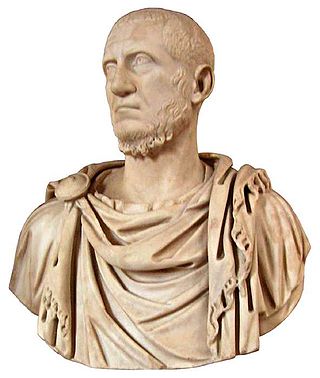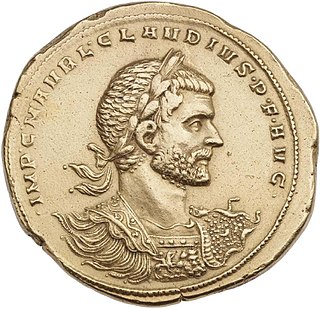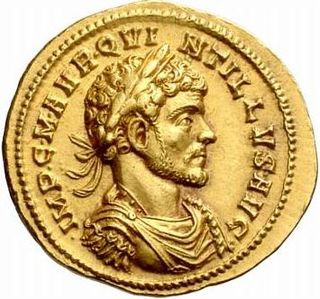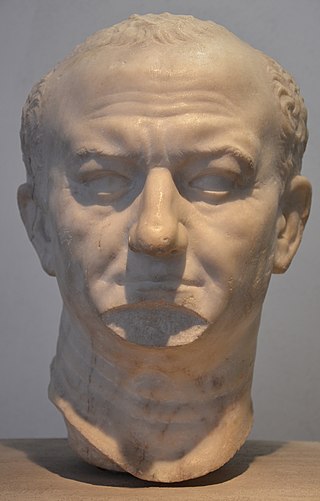Related Research Articles

Marcus Claudius Tacitus was Roman emperor from 275 to 276. During his short reign he campaigned against the Goths and the Heruli, for which he received the title Gothicus Maximus.
The 270s decade ran from January 1, 270, to December 31, 279.

Aurelian was a Roman emperor, who reigned during the Crisis of the Third Century, from 270 to 275. As emperor, he won an unprecedented series of military victories which reunited the Roman Empire after it had nearly disintegrated under the pressure of barbarian invasions and internal revolts. Born in modest circumstances, most likely in Moesia Superior, he entered the Roman army in 235 and climbed up the ranks. He went on to lead the cavalry of the emperor Gallienus, until Gallienus' assassination in 268. Following that, Claudius Gothicus became emperor until his own death in 270. Claudius' brother Quintillus ruled the empire for three months, before Aurelian became emperor.
Year 270 (CCLXX) was a common year starting on Saturday of the Julian calendar. At the time, it was known as the Year of the Consulship of Antiochianus and Orfitus. The denomination 270 for this year has been used since the early medieval period, when the Anno Domini calendar era became the prevalent method in Europe for naming years.

Marcus Aurelius Claudius "Gothicus", also known as Claudius II, was Roman emperor from 268 to 270. During his reign he fought successfully against the Alemanni and decisively defeated the Goths at the Battle of Naissus. He died after succumbing to a "pestilence", possibly the Plague of Cyprian that had ravaged the provinces of the Empire.
The Battle of Naissus was the defeat of a Gothic coalition by the Roman Empire under Emperor Gallienus and the future Emperor Aurelian near Naissus. The events around the invasion and the battle are an important part of the history of the Crisis of the Third Century.

Marcus Aurelius Claudius Quintillus was a Roman emperor. He was a brother of Emperor Claudius Gothicus, whom he succeeded after Claudius' death in 270. Quintillus' claim to be emperor was challenged by Aurelian, who was proclaimed emperor by the legions he commanded. Quintillus' reign lasted no more than six months. Different sources report his cause of death as murder by his own soldiers, in battle with Aurelian, or by suicide.

The gens Petronia was a plebeian family at ancient Rome. This gens claimed an ancient lineage, as a Petronius Sabinus is mentioned in the time of Lucius Tarquinius Superbus, the last of the Roman kings, but few Petronii are mentioned in the time of the Republic. They are frequently encountered under the Empire, holding numerous consulships, and eventually obtaining the Empire itself during the brief reign of Petronius Maximus in AD 455.

The gens Aurelia was a plebeian family at ancient Rome, which flourished from the third century BC to the latest period of the Empire. The first of the Aurelian gens to obtain the consulship was Gaius Aurelius Cotta in 252 BC. From then to the end of the Republic, the Aurelii supplied many distinguished statesmen, before entering a period of relative obscurity under the early emperors. In the latter part of the first century, a family of the Aurelii rose to prominence, obtaining patrician status, and eventually the throne itself. A series of emperors belonged to this family, through birth or adoption, including Marcus Aurelius and the members of the Severan dynasty.
Vigiles or more properly the Vigiles Urbani or Cohortes Vigilum were the firefighters and police of ancient Rome.

The gens Flavia was a plebeian family at ancient Rome. Its members are first mentioned during the last three centuries of the Republic. The first of the Flavii to achieve prominence was Marcus Flavius, tribune of the plebs in 327 and 323 BC; however, no Flavius attained the consulship until Gaius Flavius Fimbria in 104 BC. The gens became illustrious during the first century AD, when the family of the Flavii Sabini claimed the imperial dignity.
Pomponia is the female name for the Pomponia gens of Ancient Rome. This family was one of the oldest families in Rome. Various women bearing this name lived during the Middle and Late Roman Republic and the Roman Empire. The oldest known Pomponia was mother of a famous Roman general; the second and third were related to each other. The relationship between these women, if any, is not known. They descended from Pomponius, the first son of Numa Pompilius, the second King of Rome.

Appius Claudius Censorinus was a fictitious usurper against Roman Emperor Claudius II, according to the unreliable Historia Augusta. He is included in the list of the Thirty Tyrants.
Titus Flavius T. f. T. n. Sabinus was a Roman politician and soldier. A native of Reate, he was the elder son of Titus Flavius Sabinus and Vespasia Polla, and brother of the Emperor Vespasian.
The gens Anicia was a plebeian family at ancient Rome, mentioned first towards the end of the fourth century BC. The first of the Anicii to achieve prominence under the Republic was Lucius Anicius Gallus, who conducted the war against the Illyrians during the Third Macedonian War, in 168 BC.
The gens Caecinia was a plebeian family of Etruscan origin at ancient Rome. Members of this gens are first mentioned in the time of Cicero, and they remained prominent through the first century of the Empire, before fading into obscurity in the time of the Flavian emperors. A family of this name rose to prominence once more at the beginning of the fifth century.
Pomponius Bassus [...]stus was a Roman Senator of Anatolian descent who lived in the Roman Empire.
Pomponia Ummidia was an Anatolian Roman noblewoman and was a prominent figure in Rome during the reigns of the Roman Emperors Gallienus, Claudius Gothicus, Quintillus and Aurelian. She lived in the period the Crisis of the Third Century in the Roman Empire.
The gens Ceionia or gens Caeionia or the Caeionii family was an ancient Roman senatorial family of imperial times. The first member of the gens to obtain the consulship was Lucius Ceionius Commodus in AD 78. The rise of this family culminated in the elevation of the emperor Lucius Verus, born Lucius Ceionius Commodus, in AD 161.
Titus Flavius Claudius Sulpicianus was a Roman statesman who served as Senator and Consul suffectus. He unsuccessfully attempted to succeed his son-in-law Pertinax as Emperor in 193.
References
- ↑ Jones, A. H. M.; Martindale, J. R.; Morris, J, The Prosopography of the later Roman Empire, Vol. I, AD 260-395 (1971), pg. 70